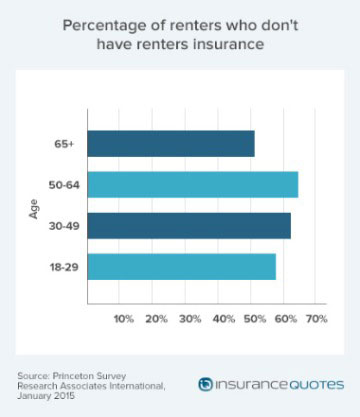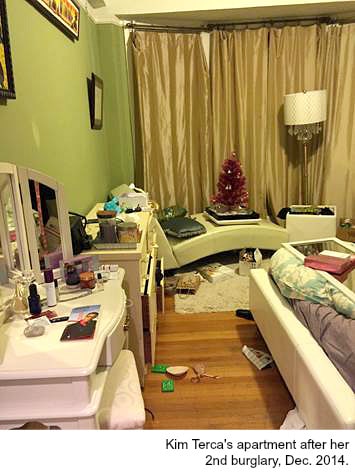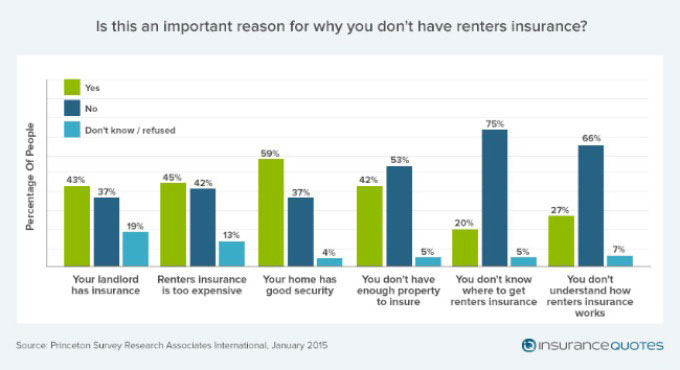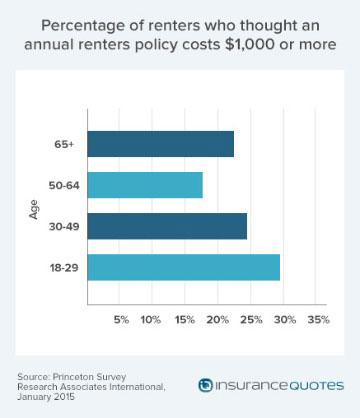Millennials lack renters insurance and believe it costs over $1,000
Your typical millennial is more likely to be a renter than an older American. However, 57 percent of millennials don’t have renters insurance, mostly because of a lack of knowledge about how coverage works.
 A new survey, conducted for insuranceQuotes.com in January 2015 by Princeton Survey Research Associates International, found that 60 percent of 18-to-29-year-olds are renters — compared with 36 percent of Americans overall — but they’re also the age group most likely to lack knowledge about renters insurance.
A new survey, conducted for insuranceQuotes.com in January 2015 by Princeton Survey Research Associates International, found that 60 percent of 18-to-29-year-olds are renters — compared with 36 percent of Americans overall — but they’re also the age group most likely to lack knowledge about renters insurance.
In fact, 37 percent of millennials said they don’t have renters insurance because they don’t know how it works. The survey also found that:
• Fifty-two percent of millennials don’t have renters insurance because they wrongly believe their landlord’s insurance will cover their belongings. “The landlord’s policy (only) will cover the structure, walls and fixtures,” says Chris Hackett, director of personal lines policy for the Property Casualty Insurers Association of America.
• Many young consumers also greatly overestimate the cost of renters insurance. Twenty-nine percent of consumers age 18 to 29 guessed that renters insurance costs $1,000 a year, though the actual average premium costs $187 a year, according to data from the National Association of Insurance Commissioners (NAIC).
“The results don’t shock me,” Sonja Larkin-Thorne, a NAIC-funded consumer representative, says of the survey. “Many people lack a basic understanding of insurance.”
 Why renters insurance matters: One renter’s story
Why renters insurance matters: One renter’s story
One consumer, 32-year-old San Francisco resident Kim Terca, learned her lesson about renters insurance the hard way.
When she was 26 years old, a thief broke into her apartment and stole items worth a few hundred dollars, including a TV and laptops. “I just hadn’t really thought about renters insurance,” Terca says.
Shortly after that incident, Terca purchased a policy for $218 a year. On Christmas Day, 2014, she came home from visiting a friend and found her studio apartment ransacked.
A burglar had climbed the fire escape, crawled in through a window, and stolen $20,000 worth of her belongings, including electronics, Christmas presents, a flute and a diamond tennis bracelet that was a family heirloom.
“Thank God I have renters insurance,” says Terca, who’s still working on compiling a list of missing items and filing her claim. “They stole a lot of stuff.”
Survey: Misinformed consumers skip renters insurance
Unlike Terca, many renters would be out of luck if disaster struck. The insuranceQuotes.com survey found that 6 out of 10 Americans who rent don’t have renters insurance.
And it’s not just millennials who lack coverage. In fact, renters ages 50 to 64 were least likely to have coverage, with 64 percent going uninsured.
And, in the 30-to-49 age group, 62 percent lacked coverage. The 18-to-29 age group did slightly better than average, with only 57 percent going uninsured.
Common reasons renters cited for not getting coverage include:
- Living in a place that has good security (59 percent).
- The landlord has insurance (43 percent).
- Renters insurance is too expensive (45 percent).
- Not having enough property to insure (42 percent).
- Not knowing how renters insurance works (27 percent).

What does renters insurance cover?
Renters who forgo insurance are taking a big risk, experts say. A renters insurance policy gives you three main types of protection:
1. Personal belongings.
A renter’s policy typically covers items such as clothes, electronics, furniture and kitchenware, Larkin-Thorne says. Many consumers wouldn’t be able to afford to replace most or all of their possessions on their own, she adds.
2. Liability.
A renter’s policy covers you for liability, such as if a visitor to your home trips on a rug and gets hurt, or a potted plant falls from your balcony and hits a pedestrian on the head, she says.
If you get sued over such an incident, renter’s insurance can help cover your legal costs and the injured person’s medical bills, according to Allstate.
 3. Living expenses after a claim.
3. Living expenses after a claim.
If you have to move out of your home due to a covered catastrophe, your renters insurance will pay a certain amount for meals and a hotel or other living space.
“It provides a roof over your head while your apartment is being repaired or while you look for another apartment,” Larkin-Thorne says.
Many consumers mistakenly think that renters insurance is only for break-ins when, in fact, it offers coverage for many unexpected scenarios.
For example, a few years ago, a candle in another tenant’s apartment caused a blaze in the building where 25-year-old Chicago resident Sarah Dietze lived.
Her $15-a-month coverage paid to replace everything from her breakfast cereal to her toothpaste, as well as to clean her belongings and put her up in a hotel.
Because Dietze had coverage, she was able to avoid the hassle of temporarily moving in with her parents an hour away from her job in the city, she says. Later, she says her landlord told her she was one of only two of about 50 tenants in the building who had insurance.
“I was terribly fortunate,” Dietze says.
How to buy the renters insurance that’s right for you
Don’t have renters insurance? Here are five tips to find the best policy for your needs:
1. Shop around.
Renters insurance is cheap, but always make sure you get the best deal by getting several free quotes.
One possible way to save: Bundle renters insurance with your auto insurance, says Katie Brewer, a Texas-based Certified Financial Planner professional who specializes in working with Generation Y clients. You can start by getting a quote from your auto insurance company.
2. Get the right type of coverage.
Some renter’s insurance policies pay the actual cash value (ACV) of your possessions, meaning what they’re worth less depreciation.
Other policies cover replacement cost, which is the amount it would cost to buy a similar item today, without deducting for depreciation.
Replacement cost policies are more expensive, but will give you a higher payment to repair or replace your belongings.
If you have anything more valuable than the old bed and bookcase your parents gave you when you moved out, go with a replacement cost policy, Larkin-Thorne says.
3. Choose the best deductible.
Make sure you get a policy with a deductible you can afford if you need to file a claim, Brewer says.
She advises clients to look at how much money they keep in emergency savings to gauge how much they could pay if disaster strikes. A fairly typical deductible is $500, but some policies have higher deductibles of $1,000 or more, Hackett says.
4. Read the fine print.
Look over the policy carefully, checking for exclusions and limits. For example, Terca, whose apartment was burglarized over the holidays, didn’t realize until after the fact that her policy has a limit of $1,500 on jewelry.
So, if you have valuables such as art, collectibles or jewelry and their value exceeds your policy coverage amount, consider getting an endorsement to your policy that offers extra coverage for those items, Hackett says.
5. Get extra coverage for catastrophes.
If you live in an area that’s prone to earthquakes or floods, a standard renters policy won’t cover you for those disasters, so you’ll need to get additional coverage, Larkin-Thorne says.
But, most importantly, don’t procrastinate. “Buying renters insurance is super easy — just a few clicks online, and you’re covered,” Terca says.
Methodology
The PSRAI January 2015 Omnibus Weeks 1 and 3 obtained telephone interviews with a nationally representative sample of 2,003 adults living in the continental United States. Telephone interviews were conducted by landline (1,001) and cell phone (1,002, including 574 without a landline phone). The surveys were conducted by Princeton Survey Research Associates International (PSRAI). Interviews were done in English by Princeton Data Source from January 8 to 11 and January 22 to 25, 2015. Statistical results are weighted to correct known demographic discrepancies. The margin of sampling error for the complete set of weighted data is ± 2.7 percentage points.
